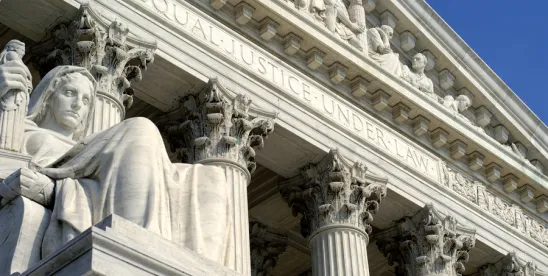With the current term of the Supreme Court soon to end, the run of decisions in which the Justices have been unanimous or close to it is being displaced by the “tougher” ones, in which there is substantial disagreement.
That disagreement is not uniformly the product of what, to many, is the expected split among jurisprudential conservatives and liberals. Indeed, some of the matchups are decidedly less predictable. This blog has discussed the now-frequent agreement between Justices Kagan and Kavanaugh, as well as the civil liberties-based independence of Justice Gorsuch. More recently, we have seen a critical reexamination of the doctrine of originalism led by Justice Barrett, and today somewhat qualified by a Second Amendment case.
Let’s start with Texas v. New Mexico and Colorado, one of those unusual original jurisdiction cases involving a dispute between states. While the opinions of a sharply divided Court are very lengthy (as apparently is the rule among the cases decided today), the holding is stark and simple. The case concerned a proposed consent decree directed at resolving a dispute over the “equitable apportionment” of the waters of the Rio Grande governed by the Rio Grande Compact, an agreement among Colorado, New Mexico, and Texas.
After a lengthy series of episodes before a special master, the state parties proposed a consent decree, but the U.S. government, which had been allowed by the Court to intervene, opposed it. Holding in favor of the government and denying the consent decree, Justice Jackson wrote for a five-Justice majority that approval of a consent decree among some parties cannot dispose of the properly raised claims of an intervenor—here, the United States—that does not consent. While Justices Thomas, Alito, Gorsuch, and Barrett dissented, essentially arguing that there were other avenues available for the government to pursue its interests and that the majority was misapplying a century’s worth of Court decisions, Justice Jackson’s majority opinion drew the support of both the Chief Justice and Justice Kavanaugh.
The outcome of the case is plainly of great import to the states that were parties and to their citizen and their agricultural, commercial, and residential interests. But the case also should be of potential interest in disputes involving private parties in cases ranging from property use to employment discrimination.
The Court returned to immigration matters in Department of State v. Muñoz. This one was a straight conservative/liberal split, with Justice Barrett writing for the majority that a citizen does not have a fundamental liberty interest in her noncitizen spouse being admitted to the country. Moreover, under the “doctrine of consular nonreviewability,” an executive officer’s decision “to admit or to exclude an alien” “is final and conclusive,” and not subject to judicial review.
The majority considered a narrow exception where the denial of a visa burdens the constitutional rights of a citizen—here, the wife. She argues that the U.S. State Department abridged her fundamental right to live with her spouse in her country of citizenship without affording her due process. While the asserted right is fundamental enough to be implicit in “liberty,” its deprivation does not require strict scrutiny.
In assessing the alleged ancillary burden on marriage, the dissent written by Justice Sotomayor raises the ghost of the Court’s reproductive rights case of Dobbs v. Jackson Women’s Health Organization, 597 U.S. 215 (2022), in which similar arguments were made, to no avail. The dissenters argued that the case should have been disposed of on narrow procedural grounds. Examining the lengthy discussion of what might have been a simple matter, one notes the increasing frequency of debates among the Justices about historical analysis. In a recent book criticizing originalism, retired Justice Stephen Breyer expressed a profoundly negative view of the Justices as historians. More recently, Justice Barrett, a conservative, raised similar concerns. And, as we are about to see today, Justice Kavanaugh, while defending originalism in a concurring opinion, has a lot to say about its metes and bounds.
Given the ongoing public debate concerning crime generally and firearms ownership particularly, the Court’s ruling in United States v. Rahimi is likely to be the subject of intense interest. In the wake of District of Columbia v. Heller, 554 U. S. 570 (2008), and more recently, McDonald v. Chicago, 561 U. S. 742 (2010), and New York State Rifle & Pistol Assn., Inc. v. Bruen, 597 U. S. 1 (2022), many critics have criticized the Supreme Court for giving virtually unlimited permission regarding the ownership and possession of firearms. Putting aside both personal and political views on the subject, the Supreme Court has made it clear that “the right to keep and bear arms,” while a fundamental right, is not an unlimited right.
In an assortment of opinions joining or concurring with that of the Chief Justice, with only Justice Thomas dissenting, the Court held that when someone has been found by a court to pose a credible threat to the physical safety of another, that person may be temporarily disarmed consistent with the Second Amendment. Reciting at great length in a manner that the Court has imposed upon itself in firearms cases, the Chief Justice has reiterated the historical record demonstrating that, since the nation’s founding, laws and regulations consistently have prevented persons who threaten physical harm to others from misusing firearms. As applied to the facts of the underlying case, 18 U. S. C. §922(g)(8), a federal statute that prohibits individuals subject to a domestic violence restraining order from possessing a firearm, was held to fit within this tradition. Note, though, that the Court’s use of the word “temporarily” means that the restriction on possession is only coextensive with the term of the restraining order. It should not be read as permanent.
Along the way, the majority reminds us that the reach of the Second Amendment is not limited only to those arms that were in existence at the time of the nation’s founding, but “extends, prima facie, to all instruments that constitute bearable arms, even those that were not [yet] in existence.” Moreover, when a firearm regulation is challenged under the Second Amendment, the government must show that the restriction “is consistent with the Nation’s historical tradition of firearm regulation.” “Consistent” means “relevantly similar,” but not identical, to laws that our tradition is understood to permit. In this case, Section 922(g)(8) is constitutional as applied to the facts of Rahimi’s own case, where he has been found by a court to pose a credible threat to the physical safety of others. Noting that, at common law, both criminal and civil actions barred such misuse of weapons.
Along the way, the Chief Justice reminds us that Heller stated that many prohibitions, like those on the possession of firearms by “felons and the mentally ill,” are “presumptively lawful” and that the Court’s conclusion in Bruen that regulations such as the surety laws are not a proper historical analogue for a broad gun licensing regime does not mean that they cannot be appropriate analogues for a narrow one.
This writer was as interested in the concurring opinion of Justice Kavanaugh as he was in the Chief Justice’s majority opinion acknowledging at least one limitation on the fundamental right guaranteed by the Second Amendment. Importantly, Kavanaugh made it clear that detailed historical analysis only takes place where constitutional text might not be clear and unambiguous. He then follows with a lengthy primer on the use of historical tools, both pre- and post-ratification, to reach judgments as to original meaning. He concludes by stating:
As exemplified by Heller, McDonald, Bruen, and the Court’s opinion today, constitutional interpretation properly takes account of text, pre-ratification and post-ratification history, and precedent. Those are the tools of the trade for an American judge interpreting the American Constitution. Of course, difficult subsidiary questions can arise about how to apply those tools, both generally and in particular cases. And in some cases, text, history, and precedent may point in somewhat different directions. In law as in life, nothing is perfect. But in Second Amendment cases as in other constitutional cases, text, history, and precedent must remain paramount.
The ordering of those requisites is interesting in several regards. Text is primary but is only so helpful, and precedent, which incorporates both custom and legal durability and predictability, is a bedrock common law characteristic. It is history that has been given preeminence, and its application by the Justices is, as Justice Barrett and retired Justice Breyer recently warned, often problematic. What several decisions of the past few weeks, including Rahimi today, demonstrate is that originalism is undergoing significant critical reexamination. That is likely to continue and may even prove crucial, no matter how the immunity case of Trump v. United States is resolved.
Erlinger v. United States produced an interesting array of Justices as the Court held that the Fifth and Sixth Amendments require a unanimous jury to make the determination beyond a reasonable doubt that a defendant’s past offenses were committed on separate occasions for purposes of determining an enhanced sentence under the Armed Career Criminal Act (ACCA), 18 U. S. C. §924(e)(1). Erlinger’s case, which, following his plea of guilty to a firearms offense, subjected him to an enhanced sentence based upon other qualifying convictions, was subject to a remand. He was able to convince the Court that there was a litigable question of whether various burglaries that he had committed occurred on different occasions, as ACCA requires, or in a single episode, and that determining the matter required factual findings that the Constitution guaranteed must be made by a jury.
Given his “liberal” bent in civil liberties cases, it should not be surprising that Justice Gorsuch delivered the Court’s opinion or that he was joined by the Chief Justice and Justices Thomas, Sotomayor, Kagan, and Barrett. Perhaps more unusual was the fact that Justices Kavanaugh, Alito, and Jackson dissented.
Finally for the day, we have an important exegesis on the subject of hearsay testimony in the case of Smith v. Arizona. Justice Kagan delivered the opinion of the Court in which all the Justices either joined or concurred in the determinative parts. In a situation typical of drug prosecutions, where the laboratory technicians who verify the nature of the substance at issue often are not available to testify at trial, the Court held that “[w]hen an expert conveys an absent analyst’s statements in support of the expert’s opinion, and the statements provide that support only if true, then the statements come into evidence for their truth.” While state law allowed the admissibility of the substitute expert for some purposes, that doesn’t transcend the constitutional requirement of a court’s conducting an independent inquiry of whether a statement is admitted for its truth. Accordingly, Arizona does not escape the Confrontation Clause just because an absent expert’s records came in to explain the basis of a testifying expert’s opinion, and the case is remanded to address the question of whether those records were testimonial.
A busy week indeed. But next week is likely to be at least as busy at the Court, with several true blockbusters left to decide.




 />i
/>i
